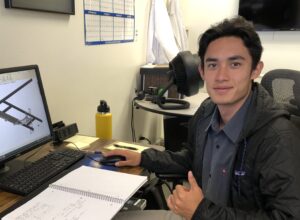
Ka’ala was born and raised on the Big Island of Hawai’i where he graduated from Ke Kula ‘O Nawahiokalani’opu’u. He is currently pursuing a BS in Mechanical Engineering and a Minor in Hawaiian Language at the University of Hawaii at Manoa. Aspiring to a career in mechanical design and manufacturing, Ka’ala plans to engage in projects that can improve his understanding of the engineering design process. In his spare time, he enjoys playing volleyball and going to the gym. Ka’ala has also recently picked up welding to expand his knowledge of assembly in order to improve his designs.
Home Island: Big Island, Hawaii
High School:
Institution when accepted: University of Hawaii at Manoa
Akamai Project: Design and Analysis of a New Work Platform in the Keck-2 Azimuth Cable Wrap Area
Project Site: W. M. Keck Observatory, Waimea, HI
Mentors: Truman Wold & Joel Payne
Project Abstract:
In 2019, the Safety and Hazard Reduction project (SHR) at W. M. Keck Observatory was appointed and placed at high priority in order to identify and resolve any potential workplace hazards. During the SHR audit, one potentially insufficient area discovered was a walking platform located above the azimuth cable wrap under the Keck-2 secondary mirror. The purpose of this platform is to allow access to an instrument housing unit known as the “dog house” and the cables located beside it. However, when the area was inspected, the platform was observed to be oriented in an abnormal manner, sitting directly on the cables and cable tray, which posed some concerns for its continuous use. As a cautionary measure, the platform was removed and the area has remained inaccessible. In order to regain access to the work area, a new platform needed to be designed and installed. To assist with design and abide by OSHA regulations, a 3D model of the area was created and analyzed using SolidWorks and Finite Element Analysis (FEA). Output from the FEA showed that the platform did not meet the allowable stress requirement under worst foreseeable use case conditions. In reviewing these FEA results with the Mechanical Engineering team, we decided to explore two options: to add additional support to the areas experiencing the most stress, or to design something that shifts the required load off of the concerning areas. Due to the difficulty of installation, along with spatial and locational constraints, the latter was pursued. Finally, a report was compiled that documents the analyses, concept designs, and evaluation of three proposed design solutions for regaining access to the work area.